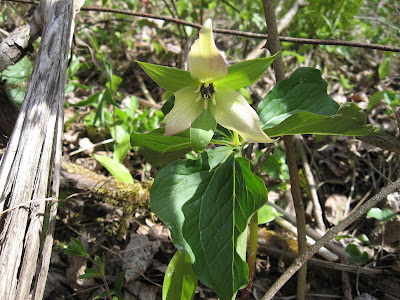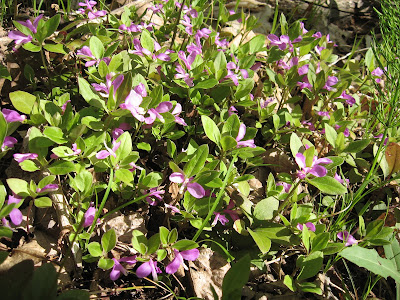The rush of spring bloom is in full swing, and no matter how many times I walk the same paths it seems like there's always something new that I've overlooked in past years. But it's impossible to patrol all of the habitats all the time, and, since the leaves develop after flowering, it looks like I missed out on seeing Round-lobed Hepatica (Anemone americana) in bloom this spring. Oh well, maybe next year ...
Although it's hard to see any similarity by a casual glance at its tiny flowers, Early Meadrowrue (Thalictrum dioicum) belongs to the same family – Ranunculaceae – as the familiar Meadow Buttercup.
A closeup of the flowers.
Red Baneberry, another member of the Buttercup family.
An unusual pale-flowered version of the well-known Red Trillium (Trillium erectum) stands out among the other deep red trilliums on the woodland floor.
Members of the Saxifrage family, Foamflowers (Tiarella cordifolia) are just coming into bloom.
Closeups of the blossoms ...
... and the leaves.
Growing along the river shore at the Price Conservation Area, a group of Sessile-leaved Bellwort (Uvularia sessilifolia) were so well hidden by rocks and a fallen tree that I almost passed them by.
Garlic Mustard (Alliaria petiolata) is a biennial, producing flowers and seeds in its second year of growth. Introduced from the Old World, it is considered to be a noxious weed.
The flowers of Hairy Bittercress (Cardamine hirsuta) are very similar to those of its much larger cousin, the Garlic Mustard, and bear the four petals typical of the mustards, family Brassicaceae or Cruciferae.
In addition to the difference in size, the leaves are quite different. This is the basal rosette ...
... a closeup of a basal leaf ...
... and a stem leaf.
It's not fully open yet, but I think this flower is White Avens (Geum canadense) – the leaves look correct for this species.
What a show! The next four species of flowers were growing within a few paces of one another. Scattered among the litter of the woodland floor were hundreds of these delicate, and aptly named, Starflowers (Trientalis borealis).
Judging by their numbers, Bluebead Lily or Yellow Clintonia (Clintonia borealis) are hardly inconspicuous or uncommon. Yet, until I literally walked into this group, I was unaware that these small lilies existed.
And another "new" flower ... Fringed Polygala or Gaywings (Polygala paucifolia).
The Bunchberry (Cornus canadensis) is a member of the Dogwood family, Cornaceae. This one is still immature, the four greenish bracts surrounding the flowers in the center will turn white in time.
Last but not least – Twining Honeysuckle (Lonicera dioica) – a botanical burst of floral fireworks to let us know that spring is really here.


































